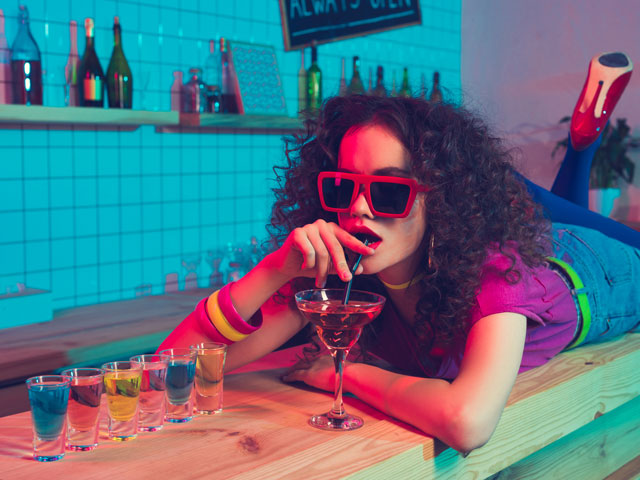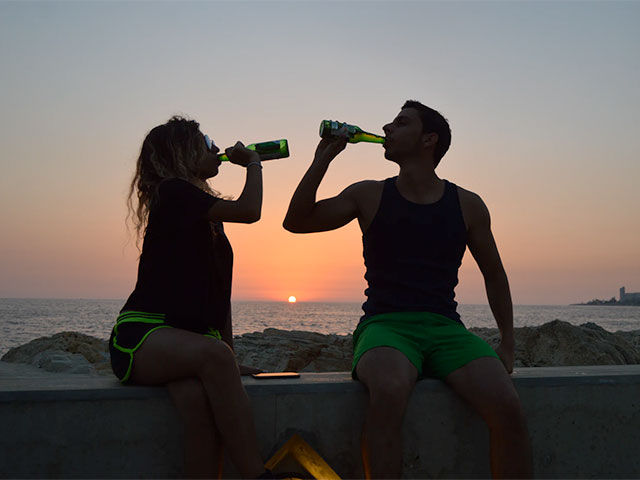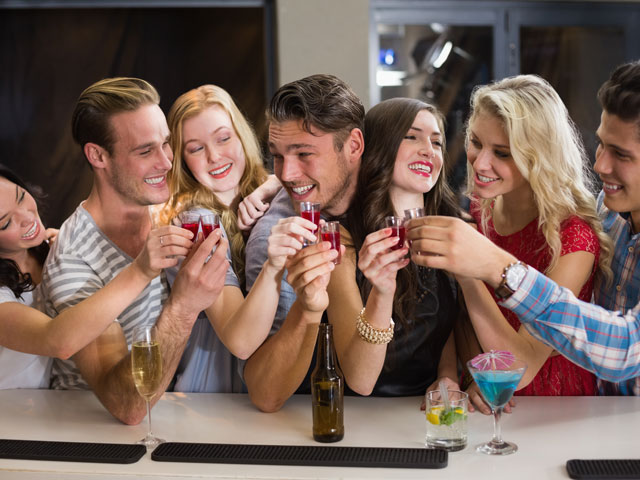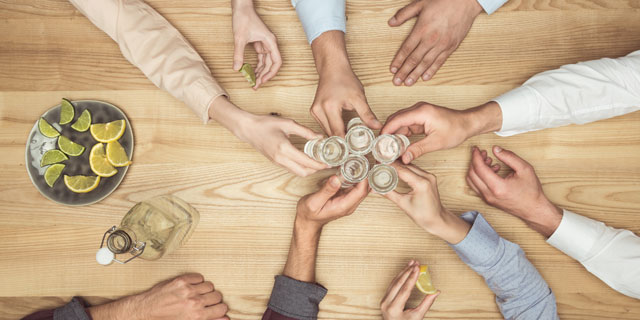How Many Shots to Get Drunk?
Whether you’re having a little whiskey with dinner or taking shots with friends, it’s important to know your own tolerance as well as how many shots you can take before getting drunk.
Written by CraftJack | Updated | 8 min read
Interesting Tools
- Beer BrüMate Hopsulator
- Brewing Northern Brewer Beer Making Kit
- Spirit Crystal Whiskey Glasses
- Wine Wine Decanter/Aerator

Unfortunately, there’s no one-size-fits-all answer – figuring out how many shots it’ll take to get drunk can depend on your age, size, and the type of alcohol you’re drinking. Not all liquor (and its alcohol content) are created equal, but here’s how you can estimate the shots you can take before you’re intoxicated.
Before we get there, you must know your limits if you are going to drink shots, especially if you are trying to determine the number of drinks (or shots) it takes to get drunk. That's what folks around the world call alcohol abuse, and it goes against sound medical advice to do so. Definitely don't try to determine amount if it's your first time drinking.
Once again, there are no health benefits to finding out how many standard drinks it takes to get drunk. What we're about to cover is purely academic, as drinking alcoholic beverages to excess is not a great idea, both in the short term (forgetting what happened the next day, lowering your inhibitions), and in the long term (increased blood pressure, potential liver disease, etc.).
Now that we have that covered, if you're doing shots, get a good shot glass. Don't settle for that 14 year old shot glass your cousin gave you from his or her college days. Unless you prefer that sort of thing.
And, don't forget to toast a shot.
Featured Types of Shots
Factors Affecting How Quickly You Get Drunk
When it comes to alcohol, everyone’s tolerance is a little different – someone who is into heavy drinking may have no trouble downing four shots, but a tiny college girl who’s never taken shots may start to feel woozy after two. There are a variety of factors that affect your tolerance and how quickly you’ll get drunk, such as:
Biological Sex
Your biological sex can play a large role in how well your body handles alcohol. Generally, women tend to get intoxicated more quickly than men because their bodies have fewer of the enzymes needed for metabolizing alcohol. Men, however, have 40% more of these enzymes, which means it’s easier for their bodies to digest and metabolize any alcohol they drink.
Body Mass/Weight
If you’ve ever wondered why the bigger people in your friend group seem to hold their alcohol better than the petite ones, it’s not a coincidence – body weight plays a large role in how quickly you get drunk. When you drink alcohol, the liquid needs to distribute through your body, and someone who’s physically bigger will have more space for the alcohol to diffuse through.
If someone who is 200 pounds and someone who’s 100 pounds both take two shots, the smaller person is likely to get more intoxicated and have a higher blood-alcohol concentration (BAC) – even though they drank the same amount.
Keep in mind that weight isn’t the only factor here either. Body composition is almost as important as your weight when it comes to alcohol tolerance. Muscle tissue in your body contains a lot of water and alcohol is more soluble in water than it is in fat. If someone who weighs 200 pounds but they’re mostly lean and muscular, they’ll often have a higher alcohol tolerance than somebody who’s 200 pounds but has more fat tissue than muscle.
Genetics
Genetics and ethnicity can impact intoxication. There’s evidence to suggest that people of Asian or Native American descent may get intoxicated faster because their bodies produce less alcohol dehydrogenase, so it’s easier for the alcohol to stay in your blood longer and become more concentrated.
Drug Interactions
Certain drugs, like antidepressants or opioids, can increase the intoxicating effects of alcohol when they’re mixed together. A single shot may not seem to affect you most of the time, but if you pair it with an opioid, it could leave you feeling intoxicated.
Even with over-the-counter painkillers like Tylenol or ibuprofen, alcohol can still be a dangerous combination. When you take the medicine with alcohol, you’re creating a “bottleneck” effect in your liver, and it means the alcohol gets absorbed slower.
This is why most doctors and pharmacists warn against mixing alcohol with certain types of drugs or medications – depending on how much medicine and alcohol you’re combining; the end result could land you in the hospital with alcohol poisoning or turn fatal.

How Quickly You’re Drinking
How quickly you’re drinking can affect blood alcohol content levels and get you drunk faster. Chances are, you’re going to feel a lot more intoxicated if you take three shots in thirty minutes versus taking three shots over three hours.
Keep in mind that the human liver can only metabolize one drink per hour, which is why it’s usually recommended that you only take one drink every sixty minutes. It's akin to chugging or shotgunning beer.
Note: How many ounces are in a shot?
An Empty Stomach
The amount of food you’ve consumed (or not consumed) before drinking is also important when it comes to how quickly you get drunk. If you’re drinking on an empty stomach, you may begin to feel the intoxication in as quickly as thirty minutes or less. This is because any food in your stomach is going to automatically slow down how fast your body is able to absorb alcohol.
There’s even evidence to suggest that eating a full meal and then immediately drinking could even lower your blood alcohol content levels.
However, if you’ve just eaten a full meal, the process of intoxication is a lot slower and could take up to an hour. Certain types of drinks can also determine intoxication. Bubbly drinks and sodas, for instance, may speed up the absorption process.
Dehydration
When you’re dehydrated, your blood alcohol content levels rise more quickly because there’s less water in your bloodstream to dilute the alcohol you’re drinking. So, if you haven’t had a sip of water all day, you may find yourself intoxicated more quickly.
There’s also evidence to suggest that alcohol can have a dehydrating effect on our bodies too. When there’s alcohol in the bloodstream, it blocks the creation of vasopressin in the pituitary gland and causes a diuretic effect. Rather than letting your body reabsorb filtered water from the kidneys, it’ll send it straight to your bladder.
Mood
You may not realize it, but even your mood can affect how intoxicated you become. Negative emotions, like anger, anxiety, or depression, can trigger changes in how the enzymes in your stomach process alcohol and could mean you end up getting drunk a little quicker.
Feeling Ill
If you’re just getting over the flu or fighting off a virus, you may not feel like drinking – but if you do, don’t be surprised if you become impaired more quickly. When you’re sick, you’re usually also dehydrated, so there’s less water in your bloodstream to dilute the alcohol you’re drinking - thus, higher blood alcohol levels. For this reason, it’s even more important to stay hydrated if you’re drinking in the midst of a cold or another type of illness.
Type of Alcohol
Of course, the type of alcohol you’re drinking can be extremely significant, too – there’s a reason why people feel more intoxicated after two shots of vodka than they do after a glass of wine. Different types of liquor each have a different amount of alcohol.

How Many Shots You Can Take Before Getting Drunk Based on Alcohol Type
Since the type of alcohol you’re drinking can be extremely important when figuring out how many shots will get you drunk, let’s discuss some different types of alcohol and their ABV percentages.
Vodka
While drinking vodka is made the same way you create beer and wine, it’s also distilled to increase the alcohol percentage dramatically. Depending on the brand, vodka’s ABV can start around 40% but go as high as 95%.
Some of the most popular vodka brands include Tito’s Handmade Vodka, Smirnoff, and Grey Goose. Most vodka you’ll find comes from wheat, corn, or another grain, although Russian vodka allegedly gets made from potatoes instead of grains. Because of this, vodka is meant to be odorless, tasteless, and pretty neutral, but you may notice subtle differences in the flavor if you switch brands.
And, unless you’re purchasing flavored vodka that may have it as an ingredient, vodka is also a type of alcohol that’s gluten-free. If gluten-free matters to you, check out these gluten-free beers.
Whiskey
Technically, all shots of whiskey would be whiskey neat, right?
Whiskey, or whisky – depending on where you’re from – is one of the more confusing types of alcohol you’ll encounter. Not only does the spelling of its name change, but there are also a couple of subcategories: scotch, bourbon, and Irish whisky. These subcategories get their gorgeous caramel color from the oak barrels they’re aged in, and while ABV can vary, most whiskeys range from 36% to 50%.
Similar to beer, whiskey comes from fermented grain juice, but it must meet several requirements before it’s considered whiskey (or one of its subcategories). Some of the common whiskey brands you may find in your local liquor store include:
- Jameson (for Irish Whisky)
- Jack Daniels
- Woodford’s Reserve (for bourbon)
- Johnnie Walker (for scotch).
Whether you add ice to your whiskey or not also factors in.
Rum
Coming from distilled molasses or sugar cane, the distillation process for rum removes any sediment, and then this alcohol gets aged in wooden barrels. Depending on the type and brand, you may find “spiced rums,” which means the rum alcohol has been flavored with additional spices for a better taste.
Like whiskey, the average ABV on rum can range from 36 to 50%, and some of the most common brands include Appleton Estate, Bacardi, Havana Club, and Ron Zacapa.
Gin
When it’s first made, gin is very similar to vodka because it starts as a neutral, distilled spirit – and some people even consider gin to be the flavored version of vodka. However, once you flavor it with juniper berries or other botanical spices, you end up with a completely different taste – although it usually still has that same, clear color that vodka does.
Gin also doesn’t always end up as strong as vodka, and it’s normal for this alcohol to have an ABV of 36 to 50%, just like whiskey or rum. Some of the more popular gin brands include Bombay, Hendricks, Beefeater, and Gordons.

Tequila
The blue agave plant, which you’ll find in Mexico, is what tequila is fermented from. For many years, the most popular way to drink tequila was as a shot, but as the quality has gotten better in recent years, some people have even begun to drink tequila like they would sip whiskey.
Given its origins, tequila is still considered a Central and South American beverage, but it’s continued to stay popular in the US. The ABV for most tequila sits at around 50%, and if you’re purchasing it, you’re likely to see brands like Patron, Don Julio, Hornitos, and Jose Cuervo.
Wine
While you may not take shots of wine like you would with vodka or tequila, there are other types of alcoholic drinks worth mentioning. If you’re drinking fortified wine, which either includes brandy or has fermented longer than most wine, it’s not unusual to see an ABV of 16 to 24%, depending on the brand.
For unfortified wine that doesn’t include brandy or have the long fermentation time, that ABV is usually around 14% or even a little lower. Wine brands and vineyards can vary by location, but some of the most popular names you’ll see over and over again include Yellow Tail, Barefoot Cellars, Franzia, and Sutter Home.
Read on to learn how to open wine without a corkscrew.
Beer and Malt Beverage
Like wine, beer is a broad term, and it can encompass plenty of subcategories – like lagers, ales, and pilsners. The brewing process can play a large role in the ABV percentage you find on the back of your beer can, but generally, the range is between 4 to 8%. However, it’s not unusual to find up to 12% on some craft beers, depending on the brand.
For malt beverages, which can also include some types of beer, that ABV can easily go up to 15% with the added alcohol.
When it comes to identifying popular beer brands, some of the names you’ll find everywhere include Corona, Heineken, Guinness, Budweiser, and Coors.
For malt beverages, Mickey’s and White Claw have continued to gain popularity over the past several years.
Final Thoughts
When asking how many shots to get drunk, there are a lot of factors at play – not only do you have to consider your body weight, genetics, how much you’ve eaten, and even how good of a mood you’ve been in, but you also have to factor in what your alcohol consumption is. Wine and beer have much lower ABVs than hard liquor like vodka or whiskey, so you may not feel as intoxicated over a glass of wine versus shots of vodka.
When learning your own alcohol tolerance, it’s important to understand which factors may personally affect how drunk you get, but also to explore your tolerance in a safe environment.
